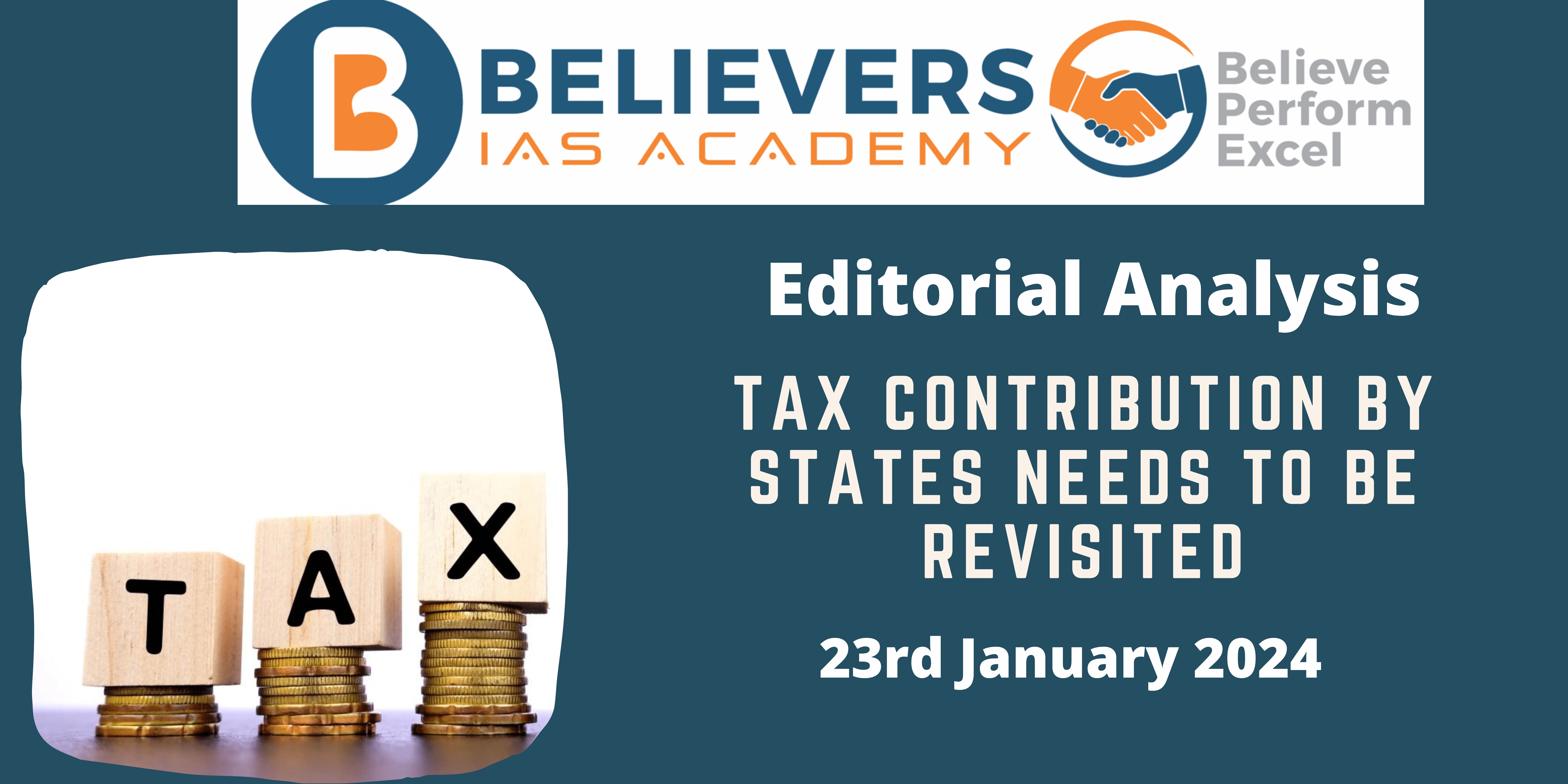Tax contribution by States needs to be revisited
Context:
The Finance Commission plays a crucial role in recommending the distribution of Union tax revenue among states. Over time, the weight assigned to tax contributions in this distribution formula has fluctuated, with the Goods and Services Tax (GST) presenting a unique opportunity to reconsider its inclusion. This article delves into the historical context of tax contribution, the evolving distribution formula, and advocates for the integration of GST and petroleum consumption as key indicators of efficiency in the formula.
Relevance:
GS-03 (Economy)
Mains Question:
Critically analyze the historical evolution of tax contribution weight in the Finance Commission’s distribution formula. With the advent of GST and considerations of stability and accuracy, discuss the potential benefits of increasing the weightage assigned to tax contribution in the context of the 16th Finance Commission. (250 words)
Dimensions of the Article:
- Evolution of Tax Contribution in Finance Commission Allocations
- Equity and Efficiency Principles in Finance Commission Allocations
- Weightage Dynamics and Emerging Efficiency Indicators
- Efficiency Indicators in Finance Commission Allocations
Evolution of Tax Contribution in Finance Commission Allocations:
- The Finance Commission, a crucial institution, plays a pivotal role in determining the allocation of Union tax revenues to various states.
- Historically, the distribution formula had assigned a marginal role to tax contributions, especially income tax. However, a significant shift occurred, notably since the 10th Finance Commission, as the importance of income tax diminished.
- The current discourse emphasizes the rising significance of tax contribution, particularly under the GST regime, positing it as a potent measure of efficiency in state revenue generation.
Equity and Efficiency Principles in Finance Commission Allocations:
- At the core of the Finance Commission’s distribution formula are the principles of equity and efficiency. Equity considerations ensure a fair allocation, taking into account revenue-scarce states and those with higher expenditures.
- On the other hand, efficiency goals aim to reward states demonstrating proficiency in both revenue collection and spending rationalization. These twin principles guide the commission in achieving a balanced and effective distribution of resources among the states.
Weightage Dynamics and Emerging Efficiency Indicators:
- The historical dynamics of weightage in the distribution formula reveal the dominance of population considerations, ranging from 80% to 90% in income tax distribution. However, post-2000 saw the introduction of efficiency indicators such as tax effort and fiscal discipline, albeit with lower weights due to their inherent instability.
- Advocacy for a stable and objective efficiency indicator becomes prominent, with an increased focus on tax contribution as a reliable measure within the distribution formula.
Efficiency Indicators in Finance Commission Allocations:
- GST as a Stable Indicator: The advent of the Goods and Services Tax (GST), a consumption-based destination tax, presents a unique opportunity in the Finance Commission’s allocation strategy. GST’s distinctive feature lies in its equal division between state and central governments, offering stability in measuring tax contributions. The relative uniformity in states’ efforts in implementing GST positions it as a compelling efficiency indicator, capable of accurately reflecting the true tax bases of different states.
- Petroleum Consumption as a Crucial Factor: Beyond GST, the consumption of petroleum emerges as another crucial efficiency indicator. Union excise duty and sales tax on petroleum, excluded from GST, represent stable burdens on states’ consumers. The cascading tax impact on petroleum products underscores their role as reliable indicators of states’ contributions to national revenue. States’ efficiency is thus influenced by their relative consumption patterns in the context of petroleum products.
- The Income Connection: The inclusion of GST revenue and petroleum consumption in the distribution formula gains further support through their correlation with residents’ incomes. These indicators, functioning as derivatives of income, provide a fair and accurate measure of states’ contributions to the national exchequer. Given the substantial share of personal and corporate income taxes in Central tax revenue, these efficiency indicators assume an integral role in ensuring an equitable and efficient distribution of financial resources among the states.
Way Forward:
- The 16th Finance Commission, recently constituted, stands at a juncture to reevaluate efficiency indicators in the distribution formula. The article urges a reconsideration of the weightage assigned to tax contribution, proposing a significant inclusion of GST revenue and petroleum consumption with a minimum weightage of 33%.
- The stability of GST and petroleum consumption indicators over time enhances their reliability. Unlike tax effort and fiscal discipline, these measures provide a consistent and objective reflection of states’ efficiency, free from discretionary policies’ impact.
- Incorporating GST revenue and petroleum consumption in the distribution formula aligns with the national interest. It ensures a fair distribution of resources, acknowledging states’ actual contributions and fostering financial stability.




